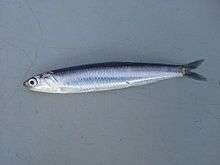European anchovy
| European anchovy | |
|---|---|
 | |
| Scientific classification | |
| Kingdom: | Animalia |
| Phylum: | Chordata |
| Class: | Actinopterygii |
| Order: | Clupeiformes |
| Family: | Engraulidae |
| Genus: | Engraulis |
| Species: | E. encrasicolus |
| Binomial name | |
| Engraulis encrasicolus (Linnaeus, 1758) | |
The European anchovy (Engraulis encrasicolus) is a forage fish somewhat related to the herring. Anchovies are placed in the family Engraulidae.
It is easily distinguished by its deeply cleft mouth, the angle of the gape being behind the eyes. The pointed snout extends beyond the lower jaw. The fish resembles a sprat in having a forked tail and a single dorsal fin, but the body is round and slender. The maximum length is 21 cm (8 1⁄8 in).
Distribution
European anchovies are abundant in the Mediterranean and formerly also the Black and Azov seas (see below). They are regularly caught on the coasts of Bulgaria, Croatia, France, Georgia, Greece, Italy, Albania, Romania, Russia, Spain, Turkey and Ukraine. The range of the species also extends along the Atlantic coast of Europe to the south of Norway. In winter it is common off Devon and Cornwall (United Kingdom), but has not hitherto been caught in such numbers as to be of commercial importance.

Zuiderzee and English Channel
Formerly they were caught in large numbers off the coast of the Netherlands in summer when they entered the Wadden Sea and Zuiderzee. After the closing of the Zuiderzee they were still found in the Wadden Sea until the 1960s. They were also caught in the estuary of the Scheldt.
There is reason to believe that anchovies at the western end of the English Channel in November and December migrate from the Zuiderzee and the Scheldt in the autumn, returning there the following spring. They were believed to be an isolated population, for none come from the south in summer to occupy the English Channel, though the species does exist off the coast of Portugal. The explanation appears to be that in summer, the shallow and landlocked waters of the Zuiderzee and the sea off the Dutch coast get warmer than the coastal waters off Britain, so anchovies can spawn and maintain their numbers in warmer Dutch waters better.
Dutch naturalists on the shores of the Zuiderzee first described their reproduction and development. Spawning takes place in June and July. The eggs are buoyant and transparent like most fish eggs, but are unusual in being sausage-shaped, instead of globular. They resemble sprat and pilchard eggs in having a segmented yolk and no oil globule. Larvæ hatch two or three days after fertilization, and are minute and transparent. In August young specimens, c. 38 to 89 mm (1 1⁄2 to 3 1⁄2 in) in length, are found in the Zuiderzee, and these must derive from the previous summer's spawning.
There is no evidence to decide the question whether all the young anchovies as well as the adults leave the Zuiderzee in autumn, but, considering the winter temperature there, it is probable that they do. Eggs have also been found in the Bay of Naples, near Marseilles, off the coast of the Netherlands, and once at least off the coast of Lancashire. The occurrence of anchovies in the English Channel has been carefully studied at the Marine Biological Association Laboratory in Plymouth. They were most abundant in 1889 and 1890. In the former year considerable numbers were taken off Dover in drift nets of small mesh used for the capture of sprats. In the following December large numbers were taken together with sprats at Torquay. In November 1890 a thousand of the fish were obtained in two days from the pilchard boats fishing near Plymouth; these were caught near the Eddystone.
Black Sea and Azov Sea
In areas around the Black Sea, the European anchovy is called gávros (Γαύρος) in Greek, hamsie in Romanian, ქაფშია (Kapshia) or ქაფშა (Kapsha) in Georgian, hamsi in Turkish, hapsi in Pontic dialect of Turkish, hapsia (a "biteful") in Pontic Greek, Hapchia in Laz,[1] хамсия (hamsiya) in Bulgarian, and хамса (hamsa) in Russian and Ukrainian. Its Ancient Greek name was ἀφύη, aphýē, later Latinized into apiuva, hence the standard Italian acciuga through the Genoese dialectal anciúa. Modern Greek also uses αντζούγια antsúya, a variant of the Genoese form, for processed – as opposed to the fresh gávros – anchovy products.
Black Sea adult anchovies can reach around 12–15 cm (4 1⁄2–6 in). In the summer, hamsi migrates north to warm shallow waters of the Azov Sea to feed and breed, returning to the deep for the winter by migrating through the Strait of Kerch. During migration the fish moves in huge schools, and are actively hunted by gulls and dolphins. Hamsi makes up a considerable part of fishing and fish processing industries, either canned or frozen. In Turkey, it is the staple food of the local Black sea cuisine,[2] widely used in pan dishes, baked goods, even as dessert. In Bulgaria hamsiya is traditionally fried and served in cheap fast-food restaurants along the shore, typically with beer. Since the 1990s the dominant position of fried hamsiya is fading but still popular.
Anchovy populations in the Mediterranean were severely depleted in the 1980s by the invasive comb jelly Mnemiopsis leidyi which eats the eggs and young, they have since stabilized albeit at a much lower level.
Notes
- ↑ Özhan Öztürk. Karadeniz Ansiklopedik Sözlük. 2005. pp. 486-488
- ↑ Black Sea Region cuisine of Turkey Archived May 11, 2012, at the Wayback Machine.
References
| Wikimedia Commons has media related to European anchovy. |
- Froese, Rainer and Pauly, Daniel, eds. (2005). "Engraulis encrasicolus" in FishBase. 10 2005 version.
- Kube, Sandra; Postel, Lutz; Honnef, Christopher & Augustin, Christina B. (2007): Mnemiopsis leidyi in the Baltic Sea – distribution and overwintering between autumn 2006 and spring 2007. Aquatic Invasions 2(2): 137-145.

